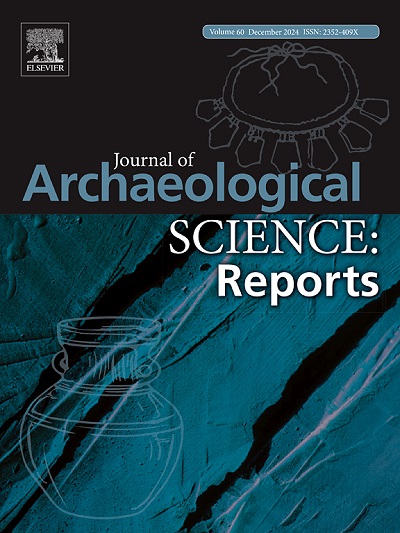阿根廷西北部一个早期家庭空间中的矿物珠:阿根廷卡塔马卡省约卡维尔山谷索里亚 2 号遗址发现的非侵入性分析技术的互补性
IF 1.5
2区 历史学
0 ARCHAEOLOGY
引用次数: 0
摘要
这项工作为阿根廷西北部和智利北部流传了数千年的半宝石制成的珠子的知识体系做出了贡献。我们提出了在Soria 2遗址(Mesada de Andalhuala-Banda, yoccavil Valley, Catamarca,阿根廷)发现的仅有的两颗珠子的成分表征。结果是通过EDS、pXRF、XRD和纳米压痕四种互补的微创分析技术的整合得到的,后者是阿根廷西北部首次应用于此类对象。结果是时间和空间背景化的,因为两个珠子都是在系统的挖掘过程中恢复的。它们来自一个可追溯到公元一千年早期的住宅结构的文献背景,这是迄今为止已知的尤卡维尔山谷最古老的住宅结构,尽管它们属于不同的社会时代:一个代表了空间作为家庭住宅的背景,而另一个则与后期有关,在此期间,废弃的房子被改造成年幼儿童的墓地。从跨学科的角度出发,这四种分析技术的互补和关键组合产生了关于选择绿色调矿物来制作珠子的新信息。经证实,其中一颗主要由绿松石组成,而另一颗则由富含铬的白云母组成。这些原材料的可能来源将根据现有数据进行介绍和讨论,旨在更深入地了解这些物品在公元第一个千年期间流通的古代相互作用网络。本文章由计算机程序翻译,如有差异,请以英文原文为准。

Mineral beads in an early domestic space of Northwest Argentina: Complementary non-invasive analytical techniques for findings from the Soria 2 site in the Yocavil Valley, Catamarca, Argentina
The work contributes to the body of knowledge on beads crafted from semi-precious stones that circulated in Northwest Argentina and Northern Chile for thousands of years. We present a compositional characterization of the only two beads, found at the Soria 2 site (Mesada de Andalhuala-Banda, Yocavil Valley, Catamarca, Argentina). The results were obtained through the integration of four complementary and minimally invasive analytical techniques: EDS, pXRF, XRD and nanoindentation, the latter being applied for the first time to this type of object in Northwest Argentina.
The results are temporally and spatially contextualized, as both beads were recovered during systematic excavations. They come from documented contexts within a residential structure dating to the early first millennium AD, the oldest known so far for the Yocavil Valley, although they belong to different social times: one represents the context when the space functioned as a household dwelling, while the other is associated with a later period, during which the abandoned house was transformed into a burial site for young children.
The complementary and critical combination of these four analytical techniques, approached from an interdisciplinary perspective, yielded novel information about the green-toned minerals selected to craft the beads. It was established that one bead is primarily composed of turquoise, while the other consists of chromium-rich muscovite. The possible sources of these raw materials are presented and discussed based on currently available data, aiming to achieve a deeper understanding of the ancient interaction networks through which these objects circulated during the first millennium AD.
求助全文
通过发布文献求助,成功后即可免费获取论文全文。
去求助
来源期刊

Journal of Archaeological Science-Reports
ARCHAEOLOGY-
CiteScore
3.10
自引率
12.50%
发文量
405
期刊介绍:
Journal of Archaeological Science: Reports is aimed at archaeologists and scientists engaged with the application of scientific techniques and methodologies to all areas of archaeology. The journal focuses on the results of the application of scientific methods to archaeological problems and debates. It will provide a forum for reviews and scientific debate of issues in scientific archaeology and their impact in the wider subject. Journal of Archaeological Science: Reports will publish papers of excellent archaeological science, with regional or wider interest. This will include case studies, reviews and short papers where an established scientific technique sheds light on archaeological questions and debates.
 求助内容:
求助内容: 应助结果提醒方式:
应助结果提醒方式:


